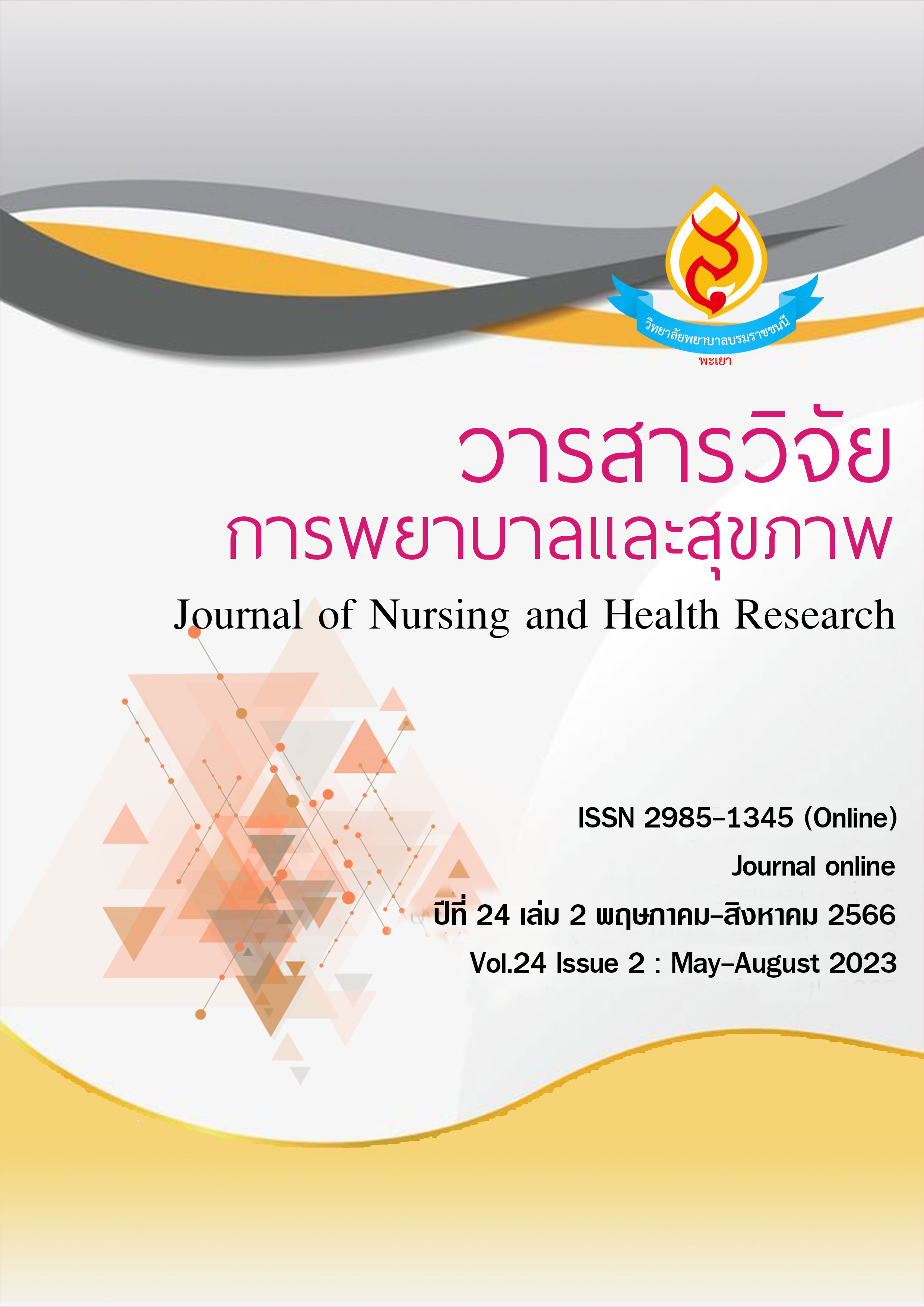การออกแบบพื้นที่สร้างสรรค์สำหรับเด็กวัยก่อนเรียน
คำสำคัญ:
พื้นที่สร้างสรรค์, เด็กวัยก่อนเรียน, การวิจัยเชิงปฏิบัติการแบบมีส่วนร่วม, รูปแบบร่องห้าโมเดลบทคัดย่อ
แนวคิดของการจัดพื้นที่สร้างสรรค์ เริ่มจากในครอบครัว และต่อยอดไปในชุมชน เพื่อส่งเสริมพัฒนาการในเด็กปฐมวัย โดยอาศัยการทำงานร่วมกันแบบสหวิชาชีพและมีระบบสนับสนุนที่ดีเพื่อให้ประสบความสำเร็จ งานวิจัยนี้เป็นวิจัยเชิงปฏิบัติการแบบมีส่วนร่วม มีวัตถุประสงค์ในการพัฒนารูปแบบพื้นที่สร้างสรรค์สำหรับเด็กวัยก่อนเรียน บ้านร่องห้า จ.พะเยา กลุ่มตัวอย่างจำนวน 70 คน ประกอบด้วย ผู้ปกครองที่นำบุตรหลานมาฝึกพัฒนาการในศูนย์เด็กเล็ก จำนวน 30 คน ผู้นำชุมชน จำนวน 30 คน และเด็กวัยรุ่นที่อายุ 14 ถึง 16 ปี จำนวน 10 คน เก็บข้อมูลระหว่าง มีนาคม-สิงหาคม 2565 เครื่องมือที่ใช้ คือคำถามปลายเปิดสำหรับการประชุมกลุ่ม การสังเกตอย่างมีส่วนร่วม และการบันทึกภาคสนาม วิเคราะห์ข้อมูลโดยใช้การวิเคราะห์แก่นสาระ (thematic analysis) ผลการวิจัย พบว่า พื้นที่สร้างสรรค์ คือ พื้นที่ของ“หอเจ้าบ้าน” สร้างฐานกิจกรรมต่าง ๆ เช่น ฐานปีนป่ายเชือก ฐานชิงช้า รูปแบบ
ในการสร้างพื้นที่สร้างสรรค์ ประกอบด้วย องค์ประกอบตามรูปแบบ ร่องห้าโมเดล (RONGHA Model) รายละเอียด ดังนี้ R: regulation ประกาศใช้กติกาชุมชน ให้เป็นกิจกรรมที่สมาชิกในชุมชนทำร่วมกัน O: organization การจัดองค์กร คือ คน เงิน เวลา สิ่งของ โดยการแต่งตั้งคณะทำงานเพื่อบริหารทรัพยากรการบริหาร และประสานงานในทุกๆ กิจกรรม N: need สำรวจความต้องการของผู้ปกครอง และนำมาออกแบบกิจกรรม G: guide ให้ความรู้กับสมาชิกในชุมชนจากวิทยากรภายนอกและปราชญ์ชาวบ้าน H: health and happily จุดเน้นของกิจกรรม คือ ส่งเสริมสุขภาพกายและจิตใจ และ A: assistance องค์กรภาครัฐและเอกชนในท้องถิ่นให้การช่วยเหลือ ดังนั้นการพัฒนาพื้นที่สร้างสรรค์สำหรับเด็กวัยก่อนเรียนต้องอาศัยความร่วมมือของเทศบาล พ่อแม่-ผู้ปกครอง แกนนำชุมชน ครูประจำศูนย์พัฒนาเด็กเล็ก ในการออกแบบกิจกรรมให้สอดคล้องกับบริบทของชุมชน
เอกสารอ้างอิง
กฤษณา จุลสงค์ และปิ่นหทัย หนูนวล. (2563). แนวทางการสร้างเครือข่ายชุมชนในการมีส่วนร่วมดูแลเด็กปฐมวัยอย่างยั่งยืน. ใน ภุชงค์ เสนานุช (บ.ก.), รายงานการประชุมการสัมมนาทางวิชาการเนื่องในโอกาสวันสถาปนาคณะสังคมสงเคราะห์ศาสตร์ มหาวิทยาลัยธรรมศาสตร์ครบรอบปีที่ 66 เรื่อง สังคมสงเคราะห์และสวัสดิการสังคม: การปลดล็อกความเหลื่อมล้ำสู่ความยั่งยืน (295- 310) . กรุงเทพฯ : มหาวิทยาลัยธรรมศาสตร์. สืบค้นเมื่อ18 สิงหาคม 2566, จาก https://socadmin.tu.ac.th/uploads/socadmin/file_document/Proceeding66year.pdf
กัญญาภัทร ศรีเมือง. (2560). การมีส่วนร่วมของชุมชนในการบริหารจัดการ ศูนย์พัฒนาเด็กเล็กขององค์กรปกครองส่วนท้องถิ่น จังหวัดฉะเชิงเทรา. ในมหาวิทยาลัยราชภัฏสวนสุนันทา. การประชุมวิชาการเสนอผลงานวิจัยระดับชาติและนานาชาติ ครั้งที่ 8 25-26 มีนาคม 2559 (หน้า 201-212). มหาวิทยาลัยราชภัฏสวนสุนันทา.
ชุติมา ทองวชิระ, สุชาดา โทผล, ณัฏฐ์พัชร เถียรวรกานต์, สมศักดิ์ เจริญพูล, จันทรกานต์ ทรงเดช, ณัฐธิดา กิจเนตร, ... สุทัศน์ ด่านตระกูล. (2561). ชุมชนสุขภาวะบนพื้นฐานศักยภาพของชุมชนและการมีส่วนร่วมของภาคีเครือข่าย: กรณีศึกษาชุมชนท่าเสด็จ อำเภอเมือง จังหวัดสุพรรณบุรี.วารสารมหาวิทยาลัยนราธิวาสราชนครินทร์ สาขามนุษยศาสตร์และสังคมศาสตร์, 5(ฉบับพิเศษ), 51-61.
ธัญญพัทธ์ ภูริพินิศนันท์. (2565). การกระจายอำนาจกับการพัฒนาท้องถิ่นขององค์กรปกครองส่วนท้องถิ่นไทย. วารสาร มจร บาฬีศึกษาพุทธโฆสปริทรรศน์, 8(1), 85-100.
ปรีชา พันธ์สีดา. (2565). ความต้องการของผู้นำชุมชนในอำเภอเมือง จังหวัดหนองบัวลำภูที่มีต่อการพัฒนาท้องถิ่นของวิทยาลัยพิชญบัณฑิต. Journal of Roi Kaensarn Academi, 7(5), 377-386.
ปัณณธณร เธียรชัยพฤกษ์. (2560). การบริหารจัดการที่มีประสิทธิภาพ. วารสาร มจร สังคมศาสตร์ปริทรรศน์, 6(2), 253-267.
วลัยนารี พรมลา, สุกัลยา ศรัทธาธรรมกุล, พิลาส สว่างสุนทรเวศย์ และพินิดา จิวะไพศาลพงศ์. (2562). ความต้องการด้านสุขภาพของประชาชน ตำบลบ้านใหม่ จังหวัดปทุมธานี. วารสารวิจัยรามคำแหง (มนุษยศาสตร์และสังคมศาสตร์), 22(1), 12-18.
สมปอง สุวรรณภูมา และสำเริง ไกยวงศ์. (2561). ความต้องการและความคาดหวังของชุมชนท้องถิ่นเกี่ยวกับการให้บริการวิชาการแก่สังคมของมหาวิทยาลัยราชภัฏชัยภูมิ. วารสารวิทยาลัยสงฆ์นครลำปาง มหาวิทยาลัยมหาจุฬาลงกรณ์ราชวิทยาลัย, 7(1), 78-90.
สมศักดิ์ ศรีสันติสุข, สุกัญญา เอมอิ่มธรรม, มัทนา บัวศรี, เปาซี วานอง, อัญชนา แสงแก้ว, เว่ย หยาง, . . . และ สุภาพงษ์ ญาณไพศาล. (2563). บทบาทขององค์การบริหารส่วนตำบลต่อการบริหารจัดการขยะชุมชนสู่ความสำเร็จอย่างยั่งยืน กรณีศึกษาองค์การบริหารส่วนตำบลคูเมือง อำเภอหนองบัวแดง จังหวัดชัยภูมิ. วารสารวิจัยราชภัฏเชียงใหม่, 21(2), 112-127.
สำนักงานกองทุนสนับสนุนการสร้างเสริมสุขภาพ. (2561). แนวคิด 3 ดี สร้างสุข. สืบค้นเมื่อ 2 เมษายน 2565, จาก https://www.thaihealth.or.th/Content/44952-%.html.
สำนักงานราชบัณฑิตยสภา. (2553). กติกา. สืบค้นเมื่อ 22 ธันวาคม 2565, จากhttp://legacy.orst.go.th/knowledges
สำนักงานสถิติแห่งชาติ. (2559). การสำรวจสถานการณ์เด็กและสตรีในประเทศไทย พ.ศ. 2558-2559. สืบค้นเมื่อ 9 เมษายน 2565, จาก from https://www.unicef.org/thailand.
สำนักสารนิเทศ สำนักงานปลัดกระทรวงสาธารณสุข. (2564). พ่อแม่เลี้ยงลูกยุคโควิด เพิ่มเวลาให้ลูก ลดการดูจอของเด็ก ส่งเสริมพัฒนาการสมวัย. สืบค้นเมื่อ 23 เมษายน 2565, จาก https://pr.moph.go.th/?url= pr/detail/2/07/163139/
สุธาสินี ศรีนุ่น, ลภัสรดา หนุ่มคำ, วนลดา ทองใบ, จีราภรณ์ กรรมบุตร, สุกัญญา พูลโพธิ์กลาง, ประกายเพชร วินัยประเสริฐ, ... แสงวรรณ ตั้งแสงสกุล. (2560). ภาวะสุขภาพและความต้องการทางด้านสุขภาพของประชาชน: กรณีศึกษาชุมชนในเขตเทศบาลเมืองคลองหลวง จังหวัดปทุมธานี. วารสารสาธารณสุขศาสตร์, 47(1), 55-66.
สุพัตรา บุญเจียม. (2565). ปัจจัยที่มีความสัมพันธ์กับการพัฒนาการเด็กปฐมวัย เขตสุขภาพที่ 7. วารสารศูนย์อนามัยที่ 7 ขอนแก่น, 4(1), 40-60.
อมรรัตน์ กุลสุจริต, เพ็ญประภา ภัทรานุกรม, สุจิตรา สามัคคีธรรม, ปรีชา ปิยจันทร์, และหฤทัย กมลศิริสกุล. (2563). กระบวนการติดตั้งระบบและกลไกในการป้องกันและแก้ไขปัญหาคอร์รัปชันโดยการมีส่วน ร่วมของชุมชน: กรณีศึกษาชุมชนบางบัว เขตบางเขน และชุมชนหลังแฟลตร่วมพัฒนา เขตหลักสี่ กรุงเทพมหานคร. วารสารร่มพฤกษ์, 38(3), 7-21.
Boyce, M. R., & Katz, R. (2019). Community health workers and pandemic preparedness: current and prospective roles. Frontiers in Public Health, 7(62), 1-5. doi:10.3389/fpubh.2019.00062.
Braun, V. & Clarke, V. (2006). Using thematic analysis in psychology. Qualitative Research in Psychology, 3, 77-101.
Kemmis, S., McTaggart, R., & Nixon, R. (2014). Introducing critical participatory action research. In: Kemmis, S., McTaggart, R., & Nixon, R., The Action Research Planner. (1-31). Springer, Singapore.
Leininger, M. (2002). Culture Care Theory: A Major Contribution to Advance Transcultural Nursing Knowledge and Practices. Journal of Transcultural Nursing, 13(3), 189-192
United Nations Educational Scientific and Cultural Organization. (2021). The UNESCO sustainable tourism pledge. Retrieved March 21, 2023, from https:// www. unesco.org/en/articles/ UNESCO-sustainable-travel-pledge
ดาวน์โหลด
เผยแพร่แล้ว
เวอร์ชัน
- 09.11.2023 (2)
- 31.08.2023 (1)
รูปแบบการอ้างอิง
ฉบับ
ประเภทบทความ
สัญญาอนุญาต
ลิขสิทธิ์ (c) 2023 วารสารวิจัยการพยาบาลและสุขภาพ

อนุญาตภายใต้เงื่อนไข Creative Commons Attribution-NonCommercial-NoDerivatives 4.0 International License.



